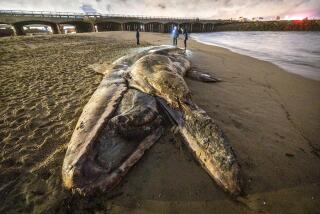Cause for Whoops
- Share via
As pre-winter storm clouds swirl with snow across Canada’s Northwest Territories, the continent’s last natural flock of whooping cranes begins its annual 2,600-mile migration to winter grounds at the Aransas National Wildlife Refuge on the Texas Gulf Coast north of Corpus Christi. This year’s migration will be particularly notable, for the flock of 84 is expected to include a vigorous, healthy crop of 16 chicks.
There is good news, as well, from the experimental flock that is being raised by sandhill cranes of New Mexico that summer in Idaho. The sandhills have been joined by 11 transplanted whooping crane chicks. Thus, if all the young survive, the whooping crane population will have increased during the past year to more than 140--a record since efforts began 47 years ago to save the majestic bird from extinction.
Dr. James Lewis of the National Fish and Wildlife Service said that this year’s chicks in the Canadian flock are “exceptionally healthy and larger than normal for their age.” Food and water conditions were excellent in the Canadian nesting grounds.
Fish and Wildlife Service efforts to create a second flock of whoopers began in 1975. Eggs from the cranes’ Canadian nests and others from a captive flock in Maryland were planted in the sandhill nests in Idaho. The chicks were raised by the sandhill cranes as their own. So far, however, the transplanted whoopers have not formed mating pairs nor had their own offspring.
The story of the whooping cranes and the less-encouraging experience of the California condor demonstrate the extraordinary difficulty of preserving a species in the wild when its numbers decline to the point of extinction. It is a lesson to remember as Congress considers renewal of the nation’s Rare and Endangered Species Act in the coming months.
More to Read
Sign up for Essential California
The most important California stories and recommendations in your inbox every morning.
You may occasionally receive promotional content from the Los Angeles Times.













